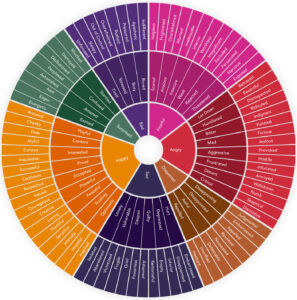Emotional intelligence, often abbreviated as EI or EQ, encompasses a spectrum of skills that allow individuals to recognize, understand, and manage their own emotions, as well as those of others. It’s about more than just being “nice” or “likable,” it’s about being astute enough to navigate the complexities of human interactions and inspire others to reach their full potential.
Emotional intelligence consists of 3 core areas:
- At the center, emotional intelligence in leadership starts with self-awareness, the ability to recognize your own emotions, strengths, weaknesses, and triggers. It’s about being honest with yourself, acknowledging imperfections, and embracing vulnerability as a source of strength rather than weakness. After all, how can a leader hope to inspire authenticity and trust in others if they’re not willing to be authentic themselves?
- From self-awareness springs self-regulation, the capacity to manage your emotions, impulses, and reactions in a constructive manner. This means refraining from knee-jerk reactions in the face of adversity, maintaining composure under pressure, and channeling emotions productively rather than allowing them to dictate behavior. It’s about cultivating resilience in the face of challenges and demonstrating grace under fire, even when the stakes are high.
- But emotional intelligence doesn’t stop at self-management, it extends to social awareness; the ability to empathize with others, understand their perspectives, and navigate the nuances of interpersonal dynamics. This involves active listening, tuning in to nonverbal cues, and fostering a culture of inclusivity where every voice is heard and valued. It’s about building bridges rather than walls, fostering collaboration instead of competition, and recognizing that diverse perspectives are a source of strength rather than division.
Emotional intelligence is the cornerstone of relationship management and the art of inspiring, influencing, and guiding others toward a shared vision. This requires effective communication, conflict resolution skills, and the capacity to build trust and rapport with team members at all levels and personality variances. It’s about leading with empathy, humility, and integrity, inspiring others not through fear or coercion, but through a genuine commitment to their growth and well-being.
So why is emotional intelligence so often dismissed or downplayed in the context of leadership?
Perhaps it’s because it defies conventional notions of power and authority, emphasizing vulnerability and connection over dominance and control. Or perhaps it’s because it’s easier to measure technical proficiency or financial acumen than it is to quantify qualities like empathy or compassion.
Measuring EQ is possible through various questionnaires, one of the most accessible and quickest to complete is the Harvard Business Review Emotional Intelligence Test. Take 5-10 minutes to navigate the questions and see your results. But don’t stop at self-awareness, dive into actionable solutions to regulate and manage yourself.
Simple & Actionable Steps Forward:
1) Self-Awareness: Utilize the Emotions Wheel provided to label emotions you run into on a daily basis. Dig beyond the surface level. Just because your physical response shows anger on the outside, what is truly being felt on the inside? Could it be feelings of betrayal being disguised with aggression? What were the thoughts that generated this response? Documentation of what you find can help identify trends.
2) Self-Regulation: When you begin to feel an excess of emotions or an intensity that typically solicits a counterproductive response, retrain yourself to begin breathing exercises. A simple box breathing method – 4-second inhale, 4-second hold, 4-second exhale, 4-second hold, repeat – can do the trick to regulate your emotions back to baseline.
3) Self-Management: Active listening is a large piece of the self-management pie and can be easily practiced through the skill of paraphrasing. It entails expressing or condensing the thoughts of the individual you’re conversing with using your own language. This method indicates your active participation in the discussion and promotes shared comprehension. It can be as straightforward as stating, “So if I’m understanding correctly…” or “Let me make sure I’ve got this right, you’re saying…”
Leaders who possess high levels of emotional intelligence are better equipped to navigate uncertainty, inspire loyalty, and drive sustainable growth in the face of relentless change. They understand that leadership is not about having all the answers, but about asking the right questions and empowering others to find solutions together.
Emotional intelligence may be a hard pill to swallow for some, but it’s a pill that’s worth swallowing if we’re serious about cultivating leaders who can truly make a difference in the world. It’s time to embrace emotional intelligence not as an afterthought or a luxury, but as the cornerstone of effective leadership in the 21st century. After all, the most successful leaders are not just masters of strategy or vision; they’re masters of human emotion and understanding.
Authored by: Alex Neagoe, Performance Coach















0 Comments